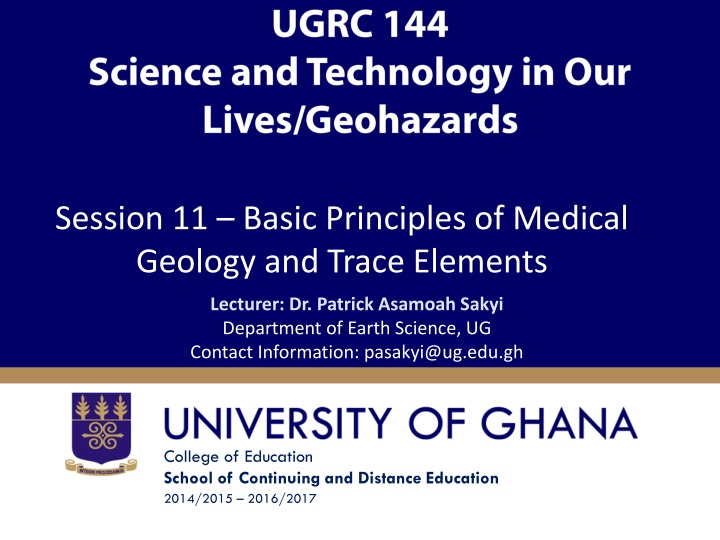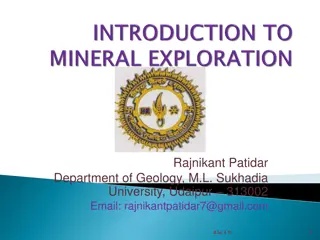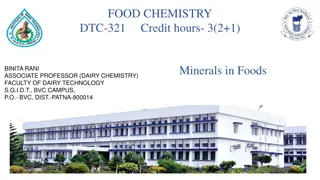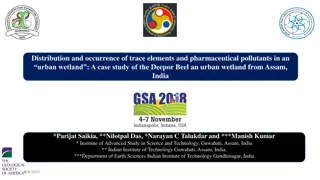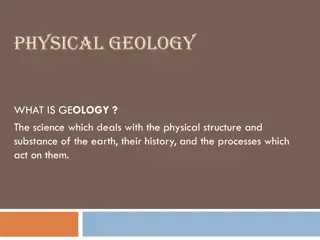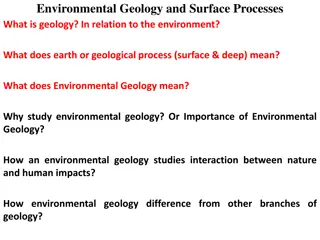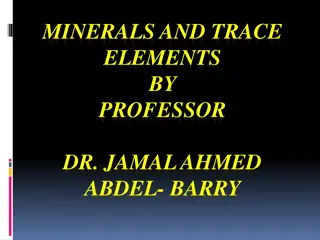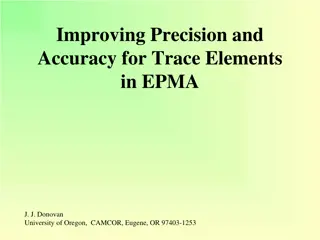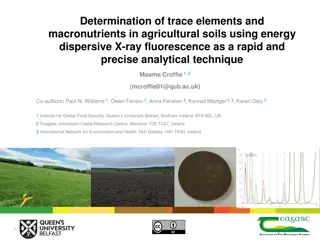Basic Principles of Medical Geology and Trace Elements Overview
This session delves into the fundamental principles of medical geology and its impact on human health. It explores how exposure to certain elements in the geologic environment can affect well-being, emphasizing pathways of trace elements into the body and their consequences. Dr. Patrick Asamoah Sakyi guides the discussion and highlights key topics including controls of trace element intake. Recommended readings further enhance understanding in this field.
Download Presentation

Please find below an Image/Link to download the presentation.
The content on the website is provided AS IS for your information and personal use only. It may not be sold, licensed, or shared on other websites without obtaining consent from the author.If you encounter any issues during the download, it is possible that the publisher has removed the file from their server.
You are allowed to download the files provided on this website for personal or commercial use, subject to the condition that they are used lawfully. All files are the property of their respective owners.
The content on the website is provided AS IS for your information and personal use only. It may not be sold, licensed, or shared on other websites without obtaining consent from the author.
E N D
Presentation Transcript
Session 11 Basic Principles of Medical Geology and Trace Elements Lecturer: Dr. Patrick Asamoah Sakyi Department of Earth Science, UG Contact Information: pasakyi@ug.edu.gh College of Education School of Continuing and Distance Education 2014/2015 2016/2017
Session Overview In this session, we shall look at the basic principles underlying medical geology. Human health can be affected by long-term exposure to either an excess or a deficiency of certain chemical and substances in the geologic environment such as soil and groundwater. The session will focus on the pathways through which trace elements from rocks, soils, and the atmosphere enter the body. The emphasis will be on some of the basic activities that we are involved in, which eventually result in the intake of geologically produced elements and the effects on our health. Slide 2 Dr. Patrick A. Sakyi, Dept. of Earth Science
Session Outline The key topics to be covered in the session are as follows: Topic One Basic Principles of Medical Geology Topic Two Pathways through which Trace Elements Enter the Body Topic Three - Controls of Trace Element Intake Slide 3 Dr. Patrick A. Sakyi, Dept. of Earth Science
Reading List Chapter 20 of Environmental Geology 4th Edition, Wm. C. Brown Publishers by Carla W Montgomery (1995) Unit 3, Sections 1 of UGRC 140 II Geohazards Institute of Continuing and Distance Education. Slide 4 Dr. Patrick A. Sakyi, Dept. of Earth Science
Topic One BASIC PRINCIPLES OF MEDICAL GEOLOGY Slide 5 Dr. Patrick A. Sakyi, Dept. of Earth Science
Basic Principles of Medical Geology Geology is an earth science comprising the study of solid Earth, the rocks of which it is composed, and the processes by which they change Medical Geology is a discipline that examines relationships between geologic materials, processes and the occurrence of human and animal diseases. The use of geologic materials such as rocks, soils, water and the atmosphere is universal. Slide 6 Dr. Patrick A. Sakyi, Dept. of Earth Science
Basic Principles of Medical Geology It has been recognized that the human and animal health can be affected through; Acute toxicity (e.g., short-term exposure to high concentrations of toxic elements) Chronic effects (i.e., long-term exposure to toxic elements) Excess or a deficiency of certain elements Slide 7 Dr. Patrick A. Sakyi, Dept. of Earth Science
Basic Principles of Medical Geology Why do Medical Geologist relate the occurrence of geologic materials and processes to human and animal health? Slide 8 Dr. Patrick A. Sakyi, Dept. of Earth Science
Basic Principles of Medical Geology Before we proceed to answer the question, let us look at the basic definitions of rock and minerals and elements. In geology, rock is a naturally occurring solid aggregate of one or more minerals. Minerals are solid inorganic substances, which occur naturally with a definite chemical composition and crystal structure. Minerals are composed of elements. Slide 9 Dr. Patrick A. Sakyi, Dept. of Earth Science
Basic Principles of Medical Geology In geochemistry, a trace element is a chemical element whose concentration is less than 1000 parts per million (ppm) or 0.1% of a rock's composition. In biochemistry, a trace element is a dietary mineral that is needed in very minute quantities for the proper growth, development, and physiological functions of animals and humans. Slide 10 Dr. Patrick A. Sakyi, Dept. of Earth Science
Basic Principles of Medical Geology In other words trace elements that are required in minutes amounts (e.g., microgram- to-milligrams per kilogram) are referred to as micronutrients. But element that are required in fairly large amounts (e.g., grams per kilogram), referred to as macronutrients, Slide 11 Dr. Patrick A. Sakyi, Dept. of Earth Science
Basic Principles of Medical Geology Among the elements considered essential elements to all animals and vegetation are; Calcium (Ca) Phosphorus(P) Potassium (K) Sulfur (S) Sodium (Na) Chlorine (Cl) Magnesium (Mg) Iron (Fe) Cobalt (Co) Copper (Cu) Carbon (C) Hydrogen (H) Oxygen (O) Nitrogen (N) Zinc (Zn) Manganese (Mg) Molybdenum (Mo) Selenium (Se) iodine (I) Bromine (Br) Slide 12 Dr. Patrick A. Sakyi, Dept. of Earth Science
Basic Principles of Medical Geology Functions of Some Elements Ca, P, Mg, F are required for structural functions in bones and membranes. Na, K, and Cl are required for the maintenance of water and electrolyte balance in cells. Zn, Cu, Se, Mn, and Mo are essential constituents of enzymes or serve as carriers for ligands in metabolism. I and Cr serve as essential components of hormones. Slide 13 Dr. Patrick A. Sakyi, Dept. of Earth Science
Basic Principles of Medical Geology Functions of Some Elements The tissue levels of these elements tend to be regulated within certain ranges, which are highly dependent on several physiological processes.. Slide 14 Dr. Patrick A. Sakyi, Dept. of Earth Science
Topic Two PATHWAYS THROUGH WHICH TRACE ELEMENTS ENTER THE BODY Slide 15 Dr. Patrick A. Sakyi, Dept. of Earth Science
Pathways through which Trace Elements Enter the Body Trace elements get in the body mainly through: The food chain Drinking water inhaled air from the atmosphere Slide 16 Dr. Patrick A. Sakyi, Dept. of Earth Science
Pathways through which Trace Elements Enter the Body The Food Chain Plants are the base on which the food chain is built. They use photosynthesis to convert CO2 into the basic molecules for metabolism such as sugars and amino acids. Water and nutrients (elements) are acquired from the soil and these are used to create new plant tissues. Slide 17 Dr. Patrick A. Sakyi, Dept. of Earth Science
Pathways through which Trace Elements Enter the Body Slide 18 Dr. Patrick A. Sakyi, Dept. of Earth Science
Pathways through which Trace Elements Enter the Body Drinking water The Water Cycle Slide 19 Dr. Patrick A. Sakyi, Dept. of Earth Science
Pathways through which Trace Elements Enter the Body Inhaled Air from the Atmosphere Slide 20 Dr. Patrick A. Sakyi, Dept. of Earth Science
Topic Three CONTROLS OF TRACE ELEMENT INTAKE Slide 21 Dr. Patrick A. Sakyi, Dept. of Earth Science
Controls of Trace Element Intake Intake of trace elements are mainly controlled by two factors, namely: Natural processes Activities of animals and humans Slide 22 Dr. Patrick A. Sakyi, Dept. of Earth Science
Controls of Trace Element Intake Natural Processes Natural processes are mainly geological processes and these include; the distribution of rocks with different elemental compositions on the surface of the earth soil formation, the movement of water in the water cycle, and the intake of nutrient from soil by plants. Slide 23 Dr. Patrick A. Sakyi, Dept. of Earth Science
Controls of Trace Element Intake Activities of Humans (and Animals) These processes are attributed to the intake of food and water, as well as other human actions and include; Diet Methods of storing food Mining Construction Pollution some agricultural practices. Slide 24 Dr. Patrick A. Sakyi, Dept. of Earth Science
Summary Both natural and human-induced activities can result in increased levels of trace elements. The natural processes depend on the variation of the underlying geology, and are difficult to control. However, human activities can modify trace elements in many ways. For examples, soil pollution with metals such as lead, zinc, copper, cadmium, arsenic and uranium, is common near smelters and other ore-processing facilities. The water pollution may be accompanied by contamination of plants growing nearby. Dr. Patrick A. Sakyi, Dept. of Earth Science Slide 25
END Slide 26 Dr. Patrick A. Sakyi, Dept. of Earth Science
